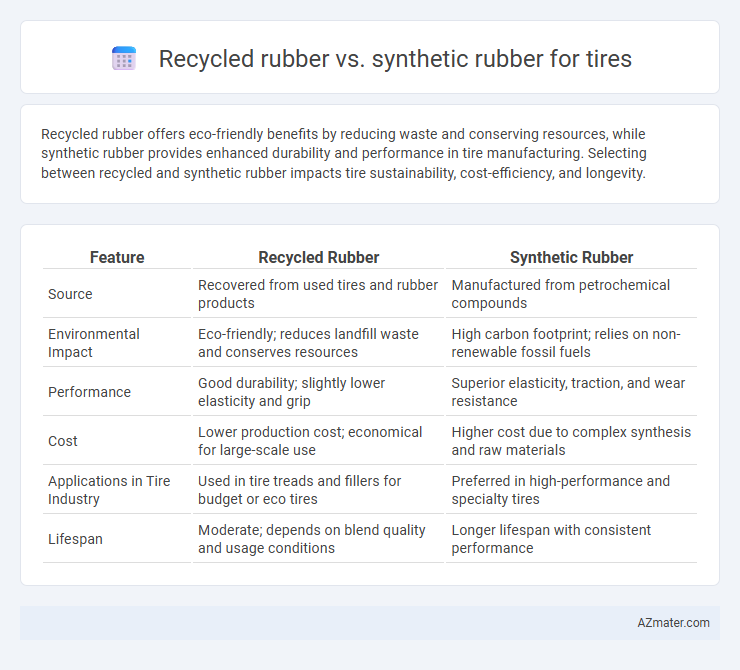Recycled rubber offers eco-friendly benefits by reducing waste and conserving resources, while synthetic rubber provides enhanced durability and performance in tire manufacturing. Selecting between recycled and synthetic rubber impacts tire sustainability, cost-efficiency, and longevity.
Table of Comparison
| Feature | Recycled Rubber | Synthetic Rubber |
|---|---|---|
| Source | Recovered from used tires and rubber products | Manufactured from petrochemical compounds |
| Environmental Impact | Eco-friendly; reduces landfill waste and conserves resources | High carbon footprint; relies on non-renewable fossil fuels |
| Performance | Good durability; slightly lower elasticity and grip | Superior elasticity, traction, and wear resistance |
| Cost | Lower production cost; economical for large-scale use | Higher cost due to complex synthesis and raw materials |
| Applications in Tire Industry | Used in tire treads and fillers for budget or eco tires | Preferred in high-performance and specialty tires |
| Lifespan | Moderate; depends on blend quality and usage conditions | Longer lifespan with consistent performance |
Introduction to Recycled and Synthetic Rubber
Recycled rubber is derived from repurposing used tires and industrial rubber waste, offering an environmentally friendly alternative by reducing landfill accumulation and conserving raw materials. Synthetic rubber is a man-made polymer produced through the polymerization of monomers such as styrene and butadiene, engineered for specific performance characteristics like durability and resistance to wear. Both materials play crucial roles in tire manufacturing, balancing sustainability with performance needs.
Overview of Tire Material Composition
Tire material composition primarily includes natural rubber, synthetic rubber, and recycled rubber, each contributing distinct properties to performance and sustainability. Synthetic rubber, derived from petrochemicals such as styrene-butadiene rubber (SBR) and butadiene rubber (BR), offers enhanced wear resistance, heat stability, and traction, making it a standard in modern tire manufacturing. Recycled rubber, sourced from processed scrap tires or manufacturing waste, is increasingly incorporated to reduce environmental impact while maintaining adequate durability and flexibility for certain tire applications.
Manufacturing Processes: Recycled vs Synthetic Rubber
Recycled rubber in tire manufacturing undergoes processes like ambient or cryogenic grinding to break down used tires into granules reused as fillers or modifiers, reducing raw material demand and environmental impact. Synthetic rubber production involves polymerization of monomers such as styrene and butadiene through emulsion or solution polymerization, offering precise control over molecular structure for tailored tire performance. The combination of recycled rubber reduces resource consumption, while synthetic rubber ensures consistent quality and elasticity, optimizing overall tire manufacturing efficiency.
Environmental Impact and Sustainability
Recycled rubber significantly reduces landfill waste and lowers the carbon footprint by repurposing discarded tires, contributing to a circular economy in tire manufacturing. Synthetic rubber production relies heavily on petroleum, leading to higher greenhouse gas emissions and resource depletion compared to recycled alternatives. Choosing recycled rubber enhances sustainability by minimizing environmental pollution and conserving non-renewable resources in tire production.
Performance and Durability Comparison
Recycled rubber in tires offers enhanced environmental benefits while maintaining good abrasion resistance but generally exhibits lower tensile strength and flexibility compared to synthetic rubber. Synthetic rubber, such as styrene-butadiene (SBR) or butadiene rubber (BR), provides superior performance with higher wear resistance, better traction in varying temperatures, and longer durability under extreme driving conditions. The advanced molecular structure of synthetic rubber ensures improved elasticity and resilience, contributing to longer tire lifespan and consistent performance on diverse road surfaces.
Cost Analysis: Recycled vs Synthetic Rubber Tires
Recycled rubber tires generally offer a lower production cost compared to synthetic rubber tires due to the reuse of waste materials and reduced raw material expenses. Synthetic rubber tires, while more expensive upfront, provide enhanced durability and performance, potentially lowering overall lifecycle costs. Cost analysis must also consider environmental impact fees, with recycled rubber often benefiting from incentives that further improve its economic appeal in tire manufacturing.
Safety Considerations and Standards
Recycled rubber tires must comply with safety standards such as DOT and ECE regulations to ensure performance under various driving conditions, including wear resistance and heat dissipation. Synthetic rubber tires are engineered to meet stringent international safety certifications, offering consistent quality and enhanced grip on wet or icy surfaces due to controlled chemical formulations. Both types require rigorous testing for impact resistance, traction, and durability to guarantee consumer safety and regulatory compliance.
Market Trends and Consumer Preferences
Recycled rubber is gaining traction in the tire market due to its eco-friendly appeal and cost-effectiveness, aligning with increasing consumer demand for sustainable products. Synthetic rubber remains dominant because of its superior performance characteristics, including durability and resistance to temperature extremes, which appeals to consumers prioritizing quality and safety. Market trends indicate a growing hybrid approach, integrating recycled rubber compounds into synthetic blends to balance environmental benefits with performance expectations.
Challenges in Implementation and Adoption
Recycled rubber faces challenges in tire manufacturing due to inconsistent material quality and limited heat resistance compared to synthetic rubber, which offers superior durability and performance. The adoption of recycled rubber is hindered by higher processing costs and compatibility issues with existing tire production technologies. Synthetic rubber remains the industry standard because of its reliable mechanical properties and scalability despite environmental concerns.
Future Innovations in Tire Rubber Technology
Future innovations in tire rubber technology emphasize enhancing the performance and sustainability of both recycled rubber and synthetic rubber. Advanced compounding techniques and molecular modifications enable recycled rubber to achieve comparable durability and elasticity to synthetic alternatives, reducing environmental impact without compromising safety. Integration of nanomaterials and bio-based additives further propels the development of tires with superior wear resistance, fuel efficiency, and lower greenhouse gas emissions.

Infographic: Recycled rubber vs Synthetic rubber for Tire
 azmater.com
azmater.com